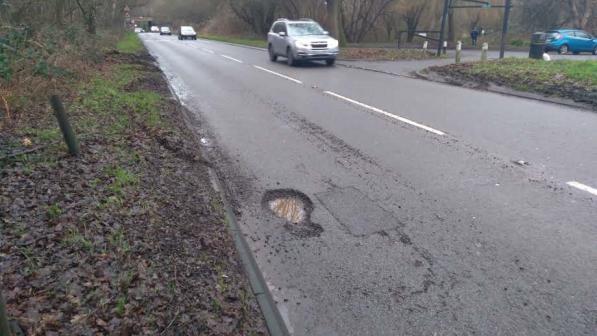Cycling UK says pothole funding is ‘sticking plaster to fix a broken leg’

The Government today revealed how the fund, first announced in the Chancellor’s Autumn Statement last November, is to be divided up between over 100 councils in England to help remove around 943,000 potholes from local roads over the next financial year.
But Cycling UK says it is nowhere near enough. Campaigns Coordinator Sam Jones said: “The Asphalt Industry Alliance estimates we need £12billion to fix England and Wales’ roads: 240 times more than the £50million a year made available in the Government’s Pothole Action Fund. It’s the equivalent of using a sticking plaster to fix a broken leg.
“Potholes can be a lethal danger to cyclists and other vulnerable road users. In 2014, the police decided that a ‘poor or defective’ road surface contributed to almost three times more crashes involving pedal cyclists than it did in those involving cars.
“Thirty cyclists were killed or seriously injured in 2010 because of poorly-maintained local roads in England and non-motorway roads in Scotland and Wales – that figure rose to 53 in 2014.
“Around 12% of the legal claims handled by Cycling UK’s Incident Line on behalf of our 67,000 members is due to poor maintenance.
“The Pothole Action Fund is worth £250million over five years and is intended to fix more than four million potholes by 2020-21. Bearing in mind the average cost of filling a pothole is £56, there’s an average of one defect for every 110 metres of road in the UK, and there are over 245,000 miles of road, it simply isn’t enough money.
Potholes can be a lethal danger to cyclists and other vulnerable road users.”
Sam Jones, Cycling UK Campaigns Coordinator
“It’s a typical smoke-and-mirrors exercise anyway, as this funding is coming out of the £6billion announced by the Coalition Government in December 2014 to tackle potholes on local authority roads.”
Cycling UK Policy Director, Roger Geffen MBE, said: “The Government has allocated £6billion over the next five years to maintain England’s trunk roads and motorways, amounting to 2% of England’s road network, yet they are only giving councils another £6billion to maintain the remaining 98% of the network over the same period.
“What that means is that 80% of the roads for long-distance traffic will be fully resurfaced, while the council-controlled local roads used by pedestrians and cyclists for local journeys are left to rot and crumble. This will inevitably mean more deaths and injuries to cyclists, with councils being forced to make utterly wasteful compensation payouts instead of being able to repair our local road networks properly.”
Cycling UK believes planned road maintenance is a more effective solution to England and Wales’ defective road surfaces, as this will address the underlying problem causing repeat potholes. As seen by the example of Plymouth Council, planned road maintenance also presents the opportunity to assess the need for, and implementation of, cycling infrastructure in a cost-efficient manner.
Cyclists and other road users can report potholes through Cycling UK’s popular Fill That Hole app.



